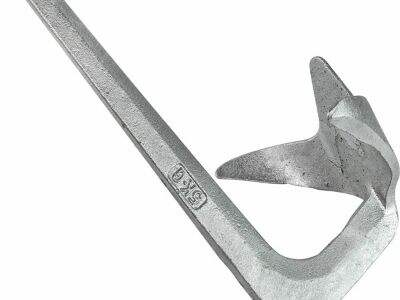الربطات الوصلية هي مكونات أساسية تُستخدم لجعل سلاسل المرساة آمنة ومستقرة. الربطات الوصلية تعتبر عناصر صغيرة بالغة الأهمية عندما يتعلق الأمر بضمان التماسك الجيد لسلسلة المرساة وأداء وظيفتها بشكل فعّال، سنلقي نظرة أقرب على دور هذه الأدوات الأساسية في سلاسل المرساة ولماذا يُعد استخدامها الصحيح أمراً مهماً لضمان إرساء آمن.
الإجراء الصحيح لتوصيلات الربطات
قد يؤدي الاستخدام غير السليم إلى انفصال السلسلة أو تفككها عندما لا تُركب الربطات الوصلية بالشكل الصحيح. وعندما يرتفع منسوب المد، فإن جزء الساق بالكامل قد خط الأنبوب مع السلسلة يجب أن يتم دفنها في أرض صلبة، ويمكن أن يكون ذلك مهددًا للحياة إذا كانت على قارب أو سفينة تحتاج إلى التثبيت داخل رصيفها إذا أصبحت الرحلة متقلبة جدًا.
مرة أخرى، تحقق من أن السلاسل المستخدمة في الوصلات مثبتة بشكل صحيح وعلى خط واحد مع حلقة سلسلة المرساة. يساعد ذلك في توزيع الوزن والضغط بالتساوي على طول السلسلة بحيث لا تتكون نقاط ضغط شديدة. ويضمن الاستخدام الصحيح للسلاسل عند وصل المفاصل أن تكون سلسلة المرساة مربوطة جيدًا ضد أي ظرف، حتى في أكثر الحالات صعوبة.
سلامة سلسلة المرساة
تلعب السلاسل المستخدمة في التوصيل دورًا أساسيًا أيضًا في سلامة سلسلة المرساة. فهي تحافظ على توصيل حلقات السلسلة مع بعضها البعض وتعمل بكفاءة تحت إجهاد وتوتر كبيرين. ال سلسلة روابط الأناشير قد لا تكون وظيفية بنفس الكفاءة بدون سلاسل توصيل، مما قد يعرّض القارب أو السفينة للخطر.
يتم الحصول على وصلة الربط بين المشبك من وزن سلسلة المرساة، ويجب تثبيتها بشكل آمن ووضعها في مكانها. هذه الأجزاء مصنوعة من مواد قوية مثل الفولاذ المقاوم للصدأ، بحيث يمكنها التحمل في البيئات البحرية القاسية. ويُعد الاستخدام الصحيح لأقفال الربط أمرًا مهمًا للحفاظ على سلامة سلسلة المرساة والسفينة.
لماذا يتم توصيل الأقفال معًا للحفاظ على ثبات سلسلة المرساة
يُعد قفل الربط من المعدات الأساسية لضمان الأداء السليم وتقديم خدمة أفضل، حيث يساعد في بقاء السلسلة متصلة في مكان واحد. فهو يربط حلقات السلسلة المختلفة مع بعضها البعض، مشكلًا اتصالاً قويًا ومتينًا يمكنه تحمل قوى المحيط. ولو لم تكن سلسلة المرساة مثبتة بأقفال ربط، فإنها ستتفكك أو تنكسر، مما يعرّض السفينة للانجراف والجنوح.
حلقة تُستخدم لتوصيل الروابط في سلسلة المرساة، بحيث يمكنها العمل كسلسلة واحدة قادرة على تحمل وزن المرساة. وغالبًا ما تُثبت الحلقات باستخدام دبوس أو برغي مثبت بآلية تمنع الحلقات من الترخي.
أهمية الحلقات لتوصيل سلسلة المرساة
تُستخدم الحلقات في التطبيقات الثابتة بشكل رئيسي لتوصيل سلسلة المرساة، وهي أيضًا مكوّن مهم في وصل السلسلة. بالإضافة إلى ذلك، بدون الحلقات، mchor على سلسلة لن تكون السلسلة قادرة على تشكيل حلقة مستمرة، ما يعني أنها ستنتهي بالانفصال أو التفكك. إنها الحلقات التي تحافظ على ثبات السلسلة في مكانها وتساعدها على مقاومة الضغوط القوية الناتجة عن البحر.
من الواضح أن السلاسل تُصنع عادةً من مواد قوية ومتينة للغاية مثل الفولاذ أو السبائك، والتي يمكنها تحمل وزن وضغط سلسلة المرساة. وتُصنع لتوفر لك اتصالاً عالي الجودة وموثوقًا، والأهم من ذلك أنه آمن، مما يضمن عدم انفصالها حتى أثناء أكثر الرحلات اضطرابًا. ويمكن أن يساعد هذا في ضمان سلامة السلسلة وموثوقيتها، حيث تقوم السلاسل بربط كل جزء من سلسلة المرساة مع الآخر.
أهمية السلاسل الواصلة في سلاسل المرساة
باختصار، فإن السلاسل الواصلة لا غنى عنها في سلاسل المرساة من حيث السلامة والأداء. من الضروري جداً توصيل السلاسل بشكل صحيح مع الشد المناسب وبدون أي تشويش للحفاظ على سلامة سلسلة المرساة. إن السلسلة الواصلة تربط حلقات السلسلة معاً لتكوين حلقة مستمرة من السلسلة قادرة على تحمل قوى الطبيعة والبحر. لو لم يتم ربط الحلقات معاً بواسطة هذه السلاسل، لكانت سلسلة المرساة عرضة للتفكك أو الكسر التام، مما يعرض السفينة ومهامها الأساسية للخطر.
 EN
EN
 AR
AR FR
FR DE
DE IT
IT JA
JA KO
KO PT
PT RU
RU ES
ES
